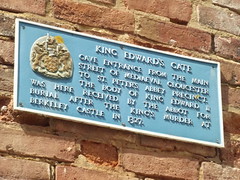King Edward II of England


King Edward II of England
(1284-1327)
Prince of Wales (1301-1307) and King of England (1307-1327)
Family tree
Commemorated on 3 plaques
The Collegiate and Parish Church of St. John the Baptist This church was founded in 1344 by Queen Isabella widow of King Edward II, on land called 'Babblake' and was granted by her to the Guild of St. John the Baptist. It was to be served by two chaplains from the 'College of Bablake'. Those priests were to say a daily mass for, the repose of the soul of her late husband King Edward II, her son King Edward III, her daughter in law Queen Phiippa, her grandson Edward the Black Prince and members of the Guild of St. John. The building was consecrated on 2nd May 1350 to God and St. John the Baptist. By the time of the dissolution of the Guilds in 1548, the church was closed and given to the Mayor of the Corporation. During the time of the Commonwealth (1642-1660), the church was used as a prison for Royalist soldiers captured at the Battle of Preston. As the sympathies of the citizens of Coventry lay with the Parliamentarians, they gave the Royalist prisoners a hostile reception giving rise to the saying 'sent to Coventry', meaning that someone is ignored or treated coldly. After many years lying empty, occasionally being used to hold markets and as a stretch yard for dyed cloth, the Corporation agreed to reopen the church as a place of worship. It was created a Parish Church on 24th July 1734. Today the church serves the spiritual and other needs of this community and the city.
St. John the Baptist Parish Church, Corporation Street, Coventry, United Kingdom where they is commemorated (1349)
"For God and St. Andrew" Robert The Bruce King of Scots planted his standard near this spot when the Scottish patriots under his command vanquished the army of Edward II of England at the Battle of Bannockburn 24th June 1314 "We fight not for glory nor for wealth, nor honour but only and alone we fight for freedom which no good man surrenders but with his life"
in the grounds of Bannockburn Heritage Centre, FK7 0LJ, Stirling, United Kingdom where they was vanquished (1314)
King Edward's Gate Gave entrance from the main street of mediaeval Gloucester to St. Peter's Abbey precinct. The body of King Edward II was here received by the Abbot for burial after the King's murder at Berkeley Castle in 1327.
King Edward's Gate - College Street, Gloucester, United Kingdom where they received (1326)



